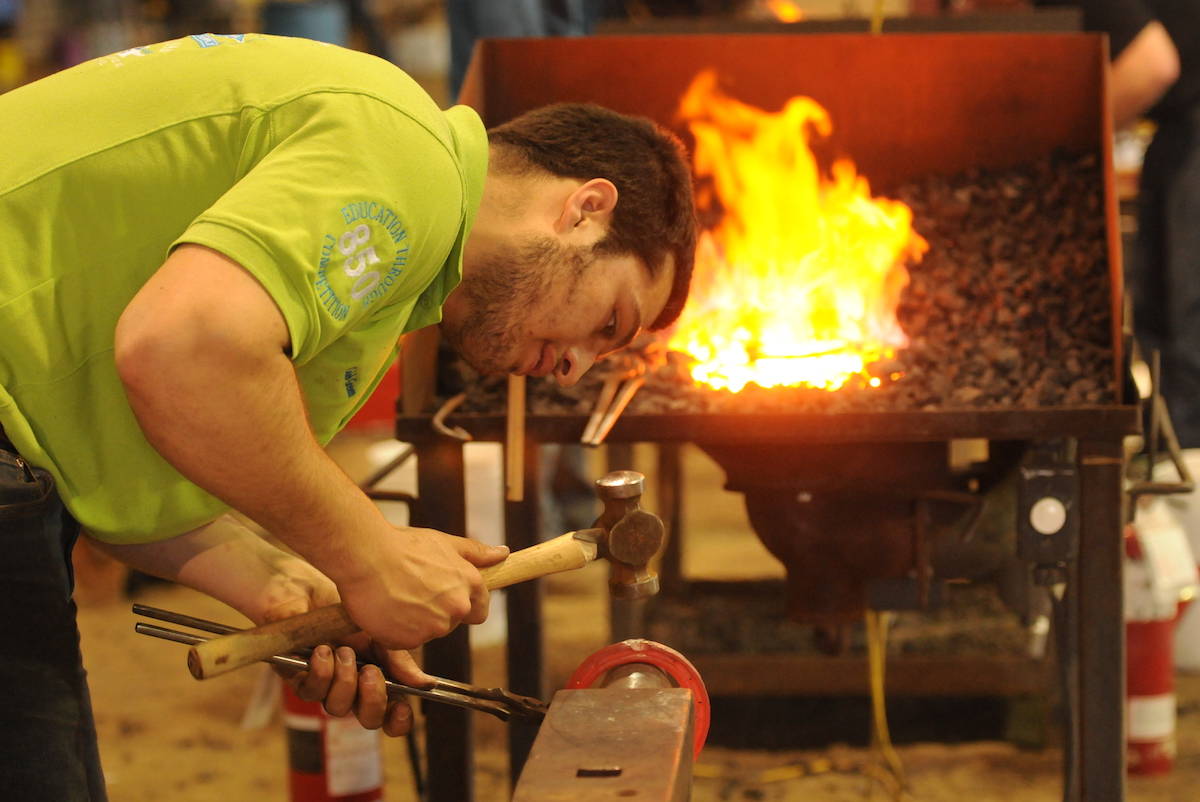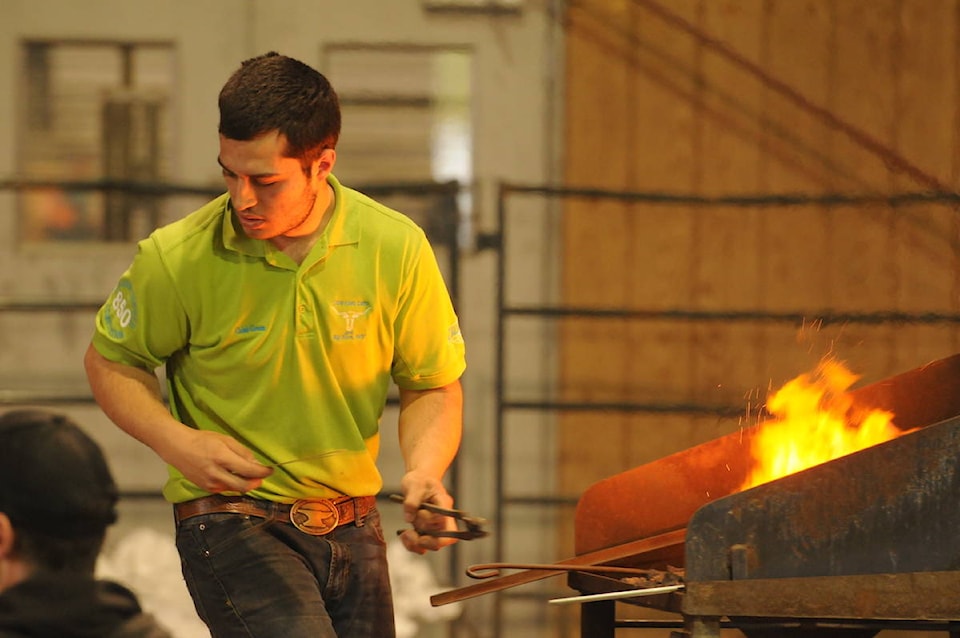The clock reads 60 minutes when Caleb Green springs into action.
On his anvil sits two pieces of metal, and by the time the clock hits zero, Caleb needs to turn them into a pair of horseshoes.
The journey from here to there is an arduous one that starts with inserting the metal into a forge fire that burns at around 3000 degrees.
The Chilliwack native spends the entire hour working within 10 feet of that fire.
“It’s a struggle because you want to stay close enough to keep an eye on your shoe, even though it’s under a bunch of coke (a coal-like fuel) and you can’t really see it,” Caleb says. “You don’t keep the fire full blast the entire time but fire management is a big thing and a skill all its own.”
When the metal is pulled from the fire, it is red hot, and for a short time until it cools off, malleable.
Caleb positions a piece on his anvil and gets to work.
If ever you thought the art of blacksmithing was dead, here is proof otherwise.
Caleb is competing in the top-level open division at the 2019 Canadian Horseshoeing Championships at Heritage Park.
The people who do this are called ‘Farriers,’ and this is their craft.
All around him hammers start dropping as they begin bending and shaping the metal to their will.
On the ground next to Caleb are two pictures of horseshoes.
“One is a ‘Double Caulking,’ which is a very agricultural shoe that you would put on a heavier draft-type horse that’s pulling,” Caleb says. “The other is a ‘Deep-Seated Bar’ that’s been forge welded to be one piece, and it’s deep seated to relieve sole pressure if a horse needs that.”
The horseshoes he produces today must conform as closely as possible to what’s in those pictures.
As Caleb will discover later, the slightest miscalculation can be the difference between first place and not.
On the surface, this appears to be a test of strength and endurance, but look beneath the surface and it’s all about precision.
Sparks fly off the metal as Caleb hammers away, his arm moving up and down like a piston.
He trades the hammer for a wire brush to scrape off surface imperfections, then returns the metal to the fire.
One piece in, one piece out and rarely does Caleb get more than a half minute’s respite.
He works with an assistant called a ‘striker,’ who is allowed to manage the fire and, on occasion, take a few swings with a heavy sledgehammer at a spot designated by Caleb.
But most of this show is Caleb’s and it tests him physically and mentally.
“There is a lot more than swinging a hammer and beating some steel,” he says. “It can be very demanding physically, but the mental side is a big factor too because you have to be able to stay calm and stay in a good head space.”
“I’ve been doing this for four years and I still don’t know half of what I should know compared to some of the guys who’ve been at this for decades.”
That includes Caleb’s dad, Jonathan, who is competing nearby and has represented Canada in international events.
“He’s a horse-shoer and if it wasn’t for him I probably wouldn’t have gone into this,” Caleb says. “I watched him do this growing up and it was something that interested me.
“I tried it in high school school and loved it because being a Farrier lets me get my competition fill in, be my own boss, work with animals and be out on farms all the time.”
As the clock hits 30 minutes, Caleb has one piece of metal bent into the U shape of a horseshoe, and seems to have a long way to go in an increasingly short time.
Halfway through this grueling competition, the mind can start playing tricks.
“It’s different every time but it’s almost always good at first when you’ve got tons of energy,” Caleb explains. “Hopefully things are going your way at that point, but you start to get more tired and you figure you’re good for time and you can slack off for a couple of heats and conserve your energy.
“But then it feels like the last 20 minutes went by in 10 minutes and you end up rushing.
“The biggest thing is to not slow down even if someone tells you you’re doing good for time.”
If Caleb is anxious on the inside it doesn’t show.
There is a fine line to be walked.
This must be done fast and it must be done right and that balance is hard to find.
But Caleb appears calm and composed, confident that the hours and hours he’s invested into preparing will pay off.
“That’s where practice comes into play with repetition and more repetition,” Caleb says. “After a while your eye develops and you don’t have to pull your ruler out as much because you know that when it looks right, it is right.
“Your anvil and your hammer are always the same, so if you practice the same moves over and over again, you should be able to repeat what you did in practice and have it turn out.”
“The craftsmanship has to be something that just happens as you’re doing it because you don’t have time to fix things.”
Sure enough, as the announcer calls out a 10 minute warning, Caleb is finishing strong.
“You try to break the hour down into sections so you know where the project should be at this point at this time,” he says.
He utilizes every last second making sure the nail holes are perfect and gives the shoes one last cleaning with the wire brush. They are still hot to the touch when the clock hits zero.
“It depends on how things went, but it’s a lot of relief when it’s over,” Caleb says. “If you know you did well it’s a lot of excitement and an adrenaline rush.
“A lot of times you’ll finish and think things look alright, but as your brain settles down and your heart-rate slows, you look at the shoes and say, ‘Oh. That’s a mistake and that’s a mistake’ and then you just think about those for the rest of the day.”
On this day, Caleb believes his shoes are properly sized, but one of them ends up being about three millimetres off in width and two or three millimetres off in length.
The narrowest margin can mean victory or defeat, and in this particular class Caleb finishes 10th out of 26.
He competes in five classes over the four-day competition, finishing 15th overall.
But he leaves with many lessons learned, confident he’ll do better the next time the forge is fired up.

